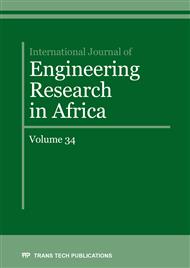[1]
M.D. Dihang, Mechanisms of coagulation and flocculation of suspensions of diluted clays encountered in water treatment. Doctoral Thesis. University Paul Sabatier. Toulouse III. France. (2007).
Google Scholar
[2]
P. Petitjean, O. Hénin, G. Gruau, Determination of organic carbon dissolved in natural fresh waters. Interest, principle, implementation and operating conditions Cahiers Techniques de Géosciences Rennes. N °3, 48p. (2004).
Google Scholar
[3]
R. Andreozzi, V. Caprio, A. Insola, R. Marotta, Advanced oxidation processes (AOP) for water purification and recovery, Catalysis Today, 53, pp.51-59. (1999).
DOI: 10.1016/s0920-5861(99)00102-9
Google Scholar
[4]
Croue J.P., Violleau D., Bodaire C. & Legube B ; Elimination of hydrophobic and hydrophilic constituents by anion exchange resin. Water Science and Technology, 40, 207-214. (1999).
DOI: 10.2166/wst.1999.0478
Google Scholar
[5]
Z. Domany, I. Galambos, G. Vatai & E. Molnar, Humic substances elimination from drinking water by membrane filtration. Desalination, 145, 333-337. (2002).
DOI: 10.1016/s0011-9164(02)00432-0
Google Scholar
[6]
H. Humbert, H. Gallard, H. Suty & J.P. Croue, Natural Organic Matter (NOM) and pesticides elimination using a combination of ion exchange resin and powdered activated carbon (PAC). Water Research, 42, 1635-1643. (2008).
DOI: 10.1016/j.watres.2007.10.012
Google Scholar
[7]
T. Putois, Study of treatment of disinfection of cooling water by coupling H2O2/ UV. Application to an air-cooling tower. Doctoral thesis. University of Grenoble. la France. (2012).
Google Scholar
[8]
Degremont, Memento technique of water, 10th Edition. Paris. France. (2005).
Google Scholar
[9]
G.S. Wang, S.F. Kang, H.J. Yang, S.Y. Pai, H.W. Chen, Elimination of dissolved natural organic matter from source water with alum coagulation. Environmental Technology, 23, 14151423. (2002).
DOI: 10.1080/09593332508618446
Google Scholar
[10]
M. Mazet, M.T. Wais Mossa, , Influence of mineral salts on the adsorption of humic acids on preformed iron hydroxide flocs, Envir. Techno, 12, 725-730. (1991).
Google Scholar
[11]
E. Lefebvre, Coagulation of aquatic humic substances by ferric iron in aqueous medium. Effect of preoxidation, Doctoral Thesis, University of Poitiers. France. (1990).
Google Scholar
[12]
S. Achour, N. Guesbaya; Tests for flocculation of humic substances in aqueous mineralized media, Larhyss Journal, 5, Juin , 171-178. University of Biskra, Algeria. (2006).
Google Scholar
[13]
F. Affoufou, N. Guesbaya and S. Achour, Effect of the mineralization of natural waters on the elimination of aromatic organic compounds by coagulation-flocculation, Courrier du Savoir Journal - 08, pp.75-81. University of Biskra, Algeria. (2007).
Google Scholar
[14]
A. Rezeg S., Achour, Mechanisms for the elimination of aromatic organic acids by aluminum sulphate and effect of mineralization; Courrier du Savoir journal - N ° 09, pp.25-31. University of Biskra. Algeria. (2009).
Google Scholar
[15]
L. Hecini, S. Achour., Study of the interactions of aluminum sulphate with phenolic compounds and effect calcic and magnesichardness water hardness. Courrier du savoir journal n ° 18, pp.83-88. University of Biskra. Algeria. (2014).
Google Scholar
[16]
J. Rodier, B. Legube, N. Merlet, R. Brunet, Water analysis - 9th edition, - Natural waters, wastewater, seawater: Water analysis, 9th edition, Paris, Dunod. (2009).
Google Scholar
[17]
M. Seve, Amino acids: Physico-chemical properties. Chapter 2; Power point, Joseph Fourier University of Grenoble. France. 29 p. (2011).
Google Scholar
[18]
S. Suresh, V.C. Srivastava and I.M. Mishra.: Adsorption of catechol, resorcinol, hydroquinone, and their derivatives: a review. International Journal of Energy and Environmental Engineering. Springer 3: 32. 19 p. (2012).
DOI: 10.1186/2251-6832-3-32
Google Scholar
[19]
S. Achour, N Guesbaya, Coagulation-flocculation by aluminum sulphate of phenolic organic compounds and humic substances. Larhyss Journal, 04, 153-168, University of Biskra, Algeria. (2005).
Google Scholar
[20]
M. Clément, R. Seux, B. Moussa, Studies of the factors determining the leakage of aluminum in feed waters prepared from waters clarified by salts of this metal, Trib. Cebedeau, 480, 336, , 469481. Liège, Belgium. (1983).
Google Scholar
[21]
N. Guesbaya, Elimination of organic compounds by the coagulation-flocculation process, Magister's thesis in hydraulic sciences, University of Biskra. Algeria. (1998).
Google Scholar
[22]
F. Julien, B. Gueroux, M. Mazet, Comparison of the elimination of organic molecules by coagulation-flocculation and by adsorption on preformed metal hydroxide flocs, Water. Res. 28, 12, 2567-2574. (1994).
DOI: 10.1016/0043-1354(94)90075-2
Google Scholar
[23]
M.T. Wais Mossa and M. Mazet, Adsorption d'acides humiques sur flocs d'hydroxydes d'aluminium : Influence de la taille des flocs et du sel d'aluminium, Envir. Technology, 12, 5158. (1990).
DOI: 10.1080/09593339109384981
Google Scholar
[24]
M. Rahni, Coagulation-flocculation of some organic compounds by ferrous iron in aqueous medium: Study of mechanism and comparison with adsorption, Thesis of Doctorate, University of Poitiers, France. (1994).
Google Scholar
[25]
L. Hecini and S. Achour, Elimination of phenol and pyrogallol by coagulation-flocculation", journal , Sciences, Technologies and Developpement. N° 8- VOL. II- ANDRU, 2011, El Harrach- Algerria (2011).
Google Scholar
[26]
S. Achour, Effect of chlorination, flocculation and adsorption processes on the evolution of organic and mineral compounds in natural waters, Doctoral Thesis, University of Tizi-ouzou, (2001).
Google Scholar


